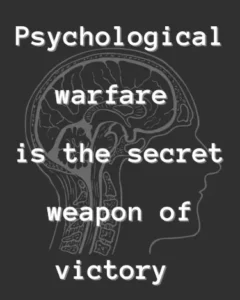Introduction: Soldier Conditioning
Throughout history, warfare has shaped societies, dictated political outcomes, and impacted millions of lives. Central to the efficacy of any military force is its ability to condition soldiers to face the harsh realities of combat. This article examines the rigorous methods for soldier conditioning employed to prepare soldiers for war, the psychological aftermath, and the often-hidden economic motivations behind global conflicts.
Dehumanization in Military Training
Language as a Tool of War

In military settings, language is strategically used to alter beliefs and emotions. Common military terms strip individuality and humanity from the enemy, making it easier for soldiers to engage in combat without internal conflict. For instance, referring to an enemy as a “target” instead of a person helps soldiers focus on mission goals over moral dilemmas. This linguistic shift is crucial for military efficiency but also raises ethical questions about the psychological impact on those who must live with these altered beliefs post-war.
The Role of Propaganda
Propaganda is a powerful psychological tool used by governments and military institutions to mold public and soldierly perception, ensuring widespread support for military actions and altering soldiers’ views of the enemy. Here’s how propaganda functions within the context of warfare:
Crafting the Enemy Image
Propaganda efforts are meticulously designed to dehumanize the enemy and justify military actions. It is also important for soldier conditioning . Through films, posters, media broadcasts, and social media, the enemy is often portrayed as a dire threat to the national way of life, emphasizing their otherness and alleged malevolence. This portrayal can include exaggeration of enemy actions, fabrication of atrocities, or simplification of complex geopolitical situations into clear-cut narratives of good versus evil.
Reinforcing National Unity and Morale
Propaganda is also used to bolster national unity and morale, promoting a sense of patriotism and duty. By appealing to national pride, historical narratives, and common values, propaganda encourages civilians and soldiers alike to support the war effort unconditionally. This is often accompanied by slogans, songs, and rallying cries that emphasize solidarity and collective action against a common enemy.
Managing Public Opinion
During wartime, controlling the flow of information is crucial. Propaganda serves to manage public opinion, often by censoring dissenting views and emphasizing positive outcomes of military engagement. Governments might downplay casualties, deny operational failures, or overly celebrate military successes to maintain public support. This selective dissemination of information helps sustain a favorable public sentiment towards the war and government policies.
Psychological Warfare

Propaganda can also extend into psychological warfare, aimed directly at weakening the enemy’s morale. Leaflets, broadcasts, and other media can be used to spread misinformation within enemy lines, sow confusion, and demoralize troops by exaggerating their own losses or questioning the legitimacy of their cause. This aspect of propaganda aims to break down enemy resistance and facilitate military success with minimal physical confrontation.
The strategic use of propaganda in war shapes not only the perceptions of those directly involved but also the global understanding of conflicts. By critically examining these messages and the motivations behind them, individuals can develop a more nuanced view of wartime narratives and resist the manipulation that often accompanies conflicts.
The Mechanics of Military Training
Repetitive Drills to Automate Actions
Military training involves extensive repetition of physical and tactical drills that make complex actions second nature. Soldier conditioning is designed to override natural human hesitancy to kill by making the mechanics of pulling a trigger an automatic response under combat conditions. These drills, often conducted under stress to simulate battlefield conditions, help soldiers react quickly and efficiently, with minimal conscious thought, thereby increasing survival rates in actual combat scenarios.
Camaraderie and Peer Pressure
The intense environment of military life fosters strong bonds among soldiers, creating a unique sense of brotherhood and belonging. This camaraderie is essential for soldier conditioning, keeping morale and unit cohesion on the battlefield. However, it also creates a powerful peer pressure to conform to group norms and behaviours, which can include aggression and dehumanization of the enemy. Soldiers may feel compelled to act against their personal morals to support solidarity and protect their comrades.
Unveiling the True Motives Behind Wars
Wars are often portrayed as necessary actions for peace and justice. However, beneath the surface of these noble declarations, the true motives are frequently rooted in economic interests and strategic advantages. Here’s a closer examination of the hidden drivers behind many global conflicts:
Economic Interests and Resource Acquisition
Historically, many wars have been initiated to gain control over valuable resources such as oil, minerals, and fertile land. For instance, the control of oil-rich regions has been a significant factor in numerous 20th and 21st-century conflicts. Nations seek to secure these resources to boost their economies, ensure energy security, and maintain geopolitical influence. This pursuit often results in long-term occupations and conflicts under the guise of national security or liberation efforts.
Strategic Geopolitical Influence
Countries also wage wars to expand their influence and power on the global stage. Gaining territorial control in strategically important locations can provide significant advantages in terms of trade routes, military bases, and political leverage. These strategic gains are often masked by the rhetoric of spreading democracy or combating tyranny, diverting public attention from the underlying ambitions of regional dominance.
Protection of Commercial Interests
Governments often justify military interventions abroad as matters of national security or humanitarian concern, but many of these actions are fundamentally driven by the need to protect corporate interests. These interventions often aim to ensure uninterrupted access to lucrative markets, safeguard foreign investments, or prevent the nationalization of industries controlled by multinational corporations. While these motives are rarely acknowledged openly, their influence on foreign policy and military strategy is undeniable.
One prominent example is the role of military intervention in regions rich in natural resources such as oil, gas, or valuable minerals. Ensuring the uninterrupted flow of these resources is critical for the economies of resource-dependent nations, and governments often deploy military forces to secure control over extraction sites, shipping routes, or pipeline infrastructure. The Gulf War of 1991 is a notable case, where protecting access to oil reserves was a central—albeit underplayed—motive behind the coalition’s actions. Similarly, interventions in Africa have often been linked to access to critical minerals such as cobalt and rare earth elements, essential for high-tech industries.
Governments also intervene to safeguard foreign investments by multinational corporations working in politically unstable regions. When corporations face threats such as expropriation, sabotage, or insurgent activities, military force is sometimes deployed under the pretext of restoring stability or protecting national citizens abroad. These operations often prioritize the continuity of corporate profits over the well-being of local populations. For instance, interventions in Latin America during the 20th century often aimed to protect the interests of agribusiness and mining conglomerates, with national governments aligning themselves with these corporate agendas.
Another motivation for military action is to prevent the nationalization of industries by foreign governments. When nations look to take control of their natural resources or industries from foreign corporations, this often threatens corporate profits and the geopolitical influence of the nations where those corporations are based. In such cases, military action or covert operations may be employed to destabilize or replace governments pursuing nationalization policies. For example, the 1953 coup in Iran, supported by Western powers, was aimed at reversing the nationalization of the country’s oil industry, which had been under British control.
Crucially, these economic motives are rarely presented transparently to the public. Instead, interventions are typically framed as efforts to uphold international law, human rights, or regional stability. Narratives about combating terrorism, promoting democracy, or protecting vulnerable populations often serve as a veneer for actions that primarily help powerful economic and corporate interests. This misrepresentation not only obscures the true motives of military interventions but also undermines public trust in government and foreign policy.
The consequences of such interventions are far-reaching. Local populations often endure the most of military actions, suffering from displacement, economic disruption, and environmental degradation. Furthermore, the prioritization of corporate interests over sustainable development and social equity can worsen inequalities and fuel resentment among affected communities, sometimes creating the very instability these interventions claim to address.
To mitigate these issues, greater transparency and accountability in foreign policy decisions are essential. Governments should have to disclose the economic interests at stake in military interventions and justify actions based on clear, evidence-based assessments of their broader impacts. Strengthening international regulations to prevent corporate exploitation in conflict zones and promoting diplomatic solutions over military responses can also reduce the harm caused by interventions driven by commercial interests. Prioritizing people over profits in international relations is critical to fostering a fair and peaceful global order.
Arms Trade and Military-Industrial Complex
The arms trade is a significant component of many economies, and the military-industrial complex benefits immensely from ongoing conflict. Wars drive demand for military equipment, supplies, and technology, providing substantial profits to manufacturers and contractors. This economic incentive can influence national policy decisions, encouraging continued military engagement rather than pursuing peace and diplomacy.
Understanding these motivations is crucial for the public to critically assess the justifications provided by leaders for war. Recognizing the economic and strategic interests at play allows citizens to demand greater transparency and accountability from their governments, ensuring that military actions are genuinely in the national interest rather than benefiting a select few.
Psychological Toll on Soldiers
The Long-lasting Effects of War
Returning soldiers often carry the psychological scars of combat, manifesting as PTSD, depression, and anxiety. The act of killing, especially under conditions of dehumanization, can leave deep mental wounds. Veterans may struggle with guilt, nightmares, and social reintegration, as the values necessary for survival in war contrast sharply with those esteemed in peaceful societies. The transition from soldier to civilian is fraught with challenges, requiring significant mental health support and societal understanding.
Conclusion
Soldiers conditioning for combat is a multifaceted process involving not just physical training but profound psychological manipulation. While these methods are designed to ensure military effectiveness, they often have lasting negative effects on individual soldiers and societal values. It’s vital to continually evaluate and discuss the ethical dimensions of military conditioning and the real reasons behind warfare.
Call to Action
What are your thoughts on the methods used to prepare soldiers for war? Do you think society does enough to support veterans returning from conflict? Share your views in the comments below and help raise awareness by sharing this article with your contacts and on social media.
Engage in this crucial conversation and help foster a more empathetic and informed society about the realities of war and its profound human impact.
References:
Can soldiers be trained to kill without being morally damaged?: https://www.abc.net.au/religion/ned-dobos-military-training-and-moral-damage/12925446
The images used to teach soldiers to kill: https://www.bbc.com/news/magazine-30573936
The Challenge of Getting Men to Kill: A View from Military Science: https://academic.oup.com/book/12748/chapter-abstract/162864298?redirectedFrom=fulltext
The Impact of Killing: How to Prepare the Soldier: https://www.pbs.org/wgbh/pages/frontline/shows/heart/themes/prep.html
And a must-read…
Trained to Kill: https://www.christianstudylibrary.org/article/trained-kill

